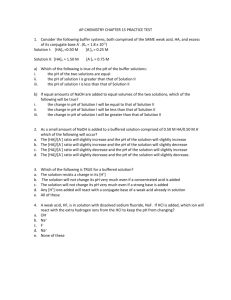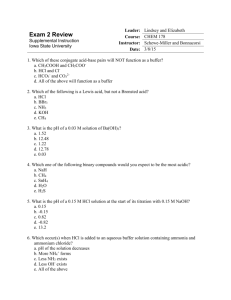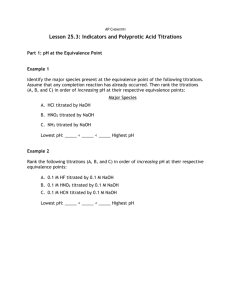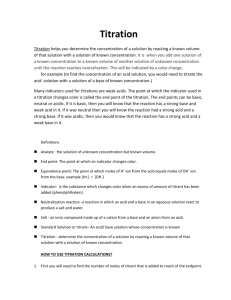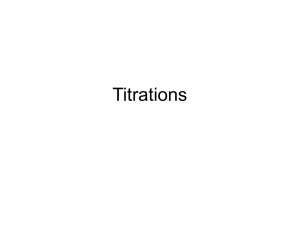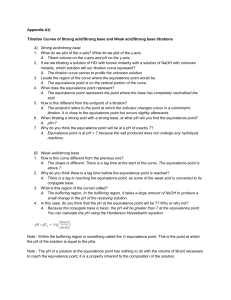Demo of Hydrolysis AlCl3, CaCl2, Na2CO3, etc
advertisement
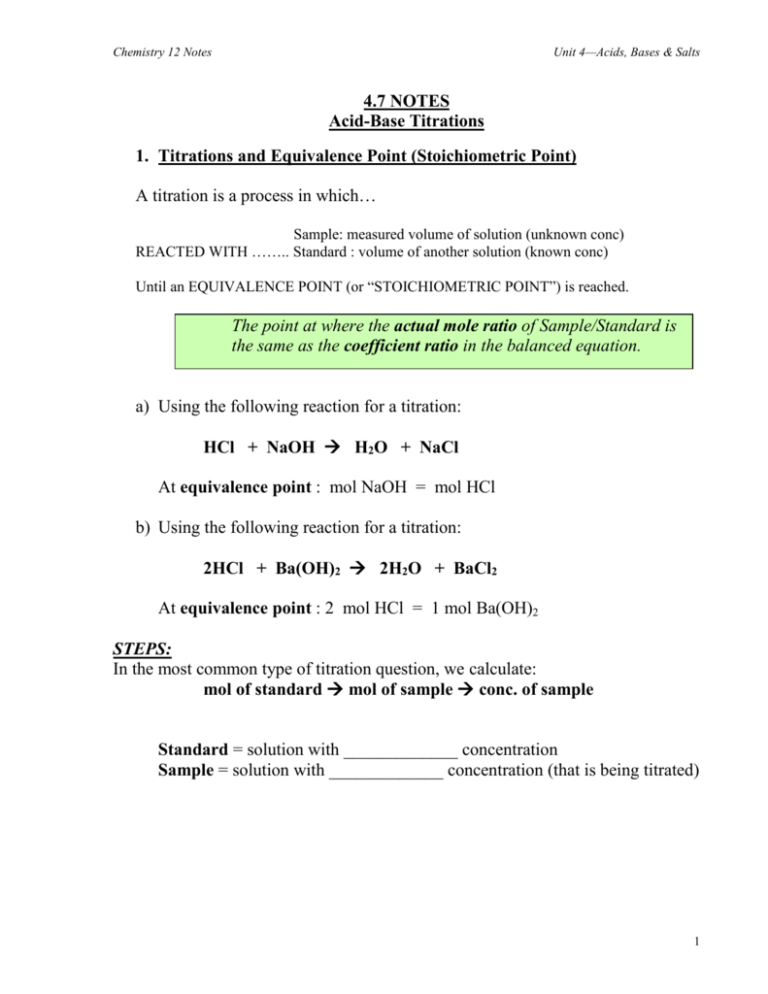
Chemistry 12 Notes Unit 4—Acids, Bases & Salts 4.7 NOTES Acid-Base Titrations 1. Titrations and Equivalence Point (Stoichiometric Point) A titration is a process in which… Sample: measured volume of solution (unknown conc) REACTED WITH …….. Standard : volume of another solution (known conc) Until an EQUIVALENCE POINT (or “STOICHIOMETRIC POINT”) is reached. The point at where the actual mole ratio of Sample/Standard is the same as the coefficient ratio in the balanced equation. a) Using the following reaction for a titration: HCl + NaOH H2O + NaCl At equivalence point : mol NaOH = mol HCl b) Using the following reaction for a titration: 2HCl + Ba(OH)2 2H2O + BaCl2 At equivalence point : 2 mol HCl = 1 mol Ba(OH)2 STEPS: In the most common type of titration question, we calculate: mol of standard mol of sample conc. of sample Standard = solution with _____________ concentration Sample = solution with _____________ concentration (that is being titrated) 1 Chemistry 12 Notes Unit 4—Acids, Bases & Salts Example #1: A solution of HCl of unknown concentration was titrated with 0.150 M Ba(OH)2. The equivalence point is reached when 14.83 mL of Ba(OH)2 is added to 50.00 mL of the HCl solution. Find the [HCl] in the original sample. Reaction: @ Equivalence Pt: 1. Find Moles of Standard( Ba(OH)2) : 2. Find moles of HCl in the sample (use the mole ratios!) 3. Find the [HCl] in sample: Example #2: A 30.0 mL sample of HBr is titrated with 0.500 M KOH. It was found that the concentration of the sample was 0.467 M HBr. What volume of KOH was added? 2 Chemistry 12 Notes Unit 4—Acids, Bases & Salts MULTIPLE TRIALS: If a series of volume readings for different “Trials” are given, you may have to discard a reading (if > 0.02 mL different from other readings). Example: 0.200 M NaOH is used to titrate 3 separate 50.0 mL samples of a solution of H2SO4 of unknown concentration. The NaOH is the standard in the burette. What average volume of NaOH was added? Initial Burette Reading (mL) Final Burette Reading (mL) Volume of NaOH added (mL) Trial 1 0.00 Trial 2 9.02 Trial 3 17.95 9.02 17.95 26.89 Significant Digits. Remember: + and = use decimal places × and ÷ = use # of SD’s Hebden (SW) Q’s: p. 158 # 94, 95 ,97 3 Chemistry 12 Notes Unit 4—Acids, Bases & Salts Titrations of Acids and Bases (pH at EQUIVALENCE POINT) SA- SB Titration: At EP, the pH = 7. The best indicator will be one that changes colour at pH = 7 (pKa = 7) but because the pH changes so quickly with every drop of base at the equivalence point, any indicator that changes colour in the range pH 3 - pH 11 will work! Titration of s trong ac id (25 c m ³) w ith s trong bas e. 14 12 10 8 pH 6 Any indicator with pKa in this range would be suitable. pH = 7 at EP 4 2 0 10 20 30 40 50 volum e (c m ³) WA- SB Titration Ex: - The pH of a weaker acid starts out higher. - At the equivalence point, the pH is > 7 Titration of weak ac id (25 c m ³) wi th s trong bas e. 14 12 10 8 pH 6 4 2 0 10 20 30 40 50 volum e (c m ³) 4 Chemistry 12 Notes Unit 4—Acids, Bases & Salts WB- SA Titration Ex : - This time a base is being titrated with a strong acid. The pH starts off above 7 but not extremely high since it is a WB. - At the equivalence point, the pH is < 7 Titration of weak bas e (25 c m ³) with s trong aci d. 14 12 10 8 pH 6 4 2 0 10 20 30 40 50 volum e (c m ³) 5



